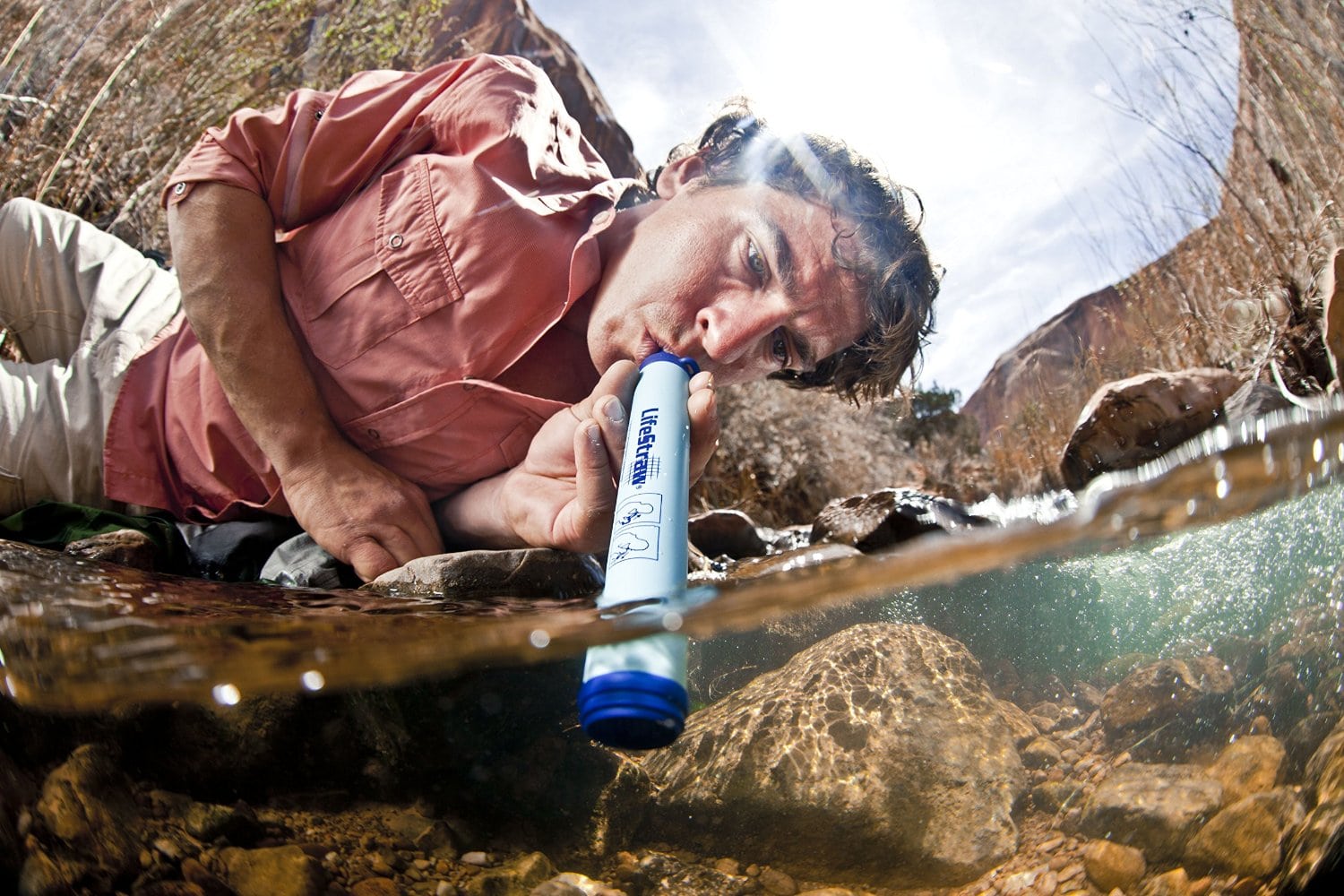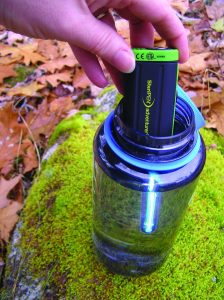The quick and easy solution for treating water is to use Potable Aqua chlorine dioxide tablets. These will purify water in about 35 minutes and work better than iodine. Don’t want to use chemicals? You might prefer a UV light water purifier such as the SteriPEN Adventurer, just remember to pack backup batteries. If you want an even faster water treatment method, our favorite solution is using a filter straw such as the Sawyer Mini. Simply attach it to your bottle or water pouch and drink immediately. What about treating water for large groups? The best gravity filter is the Platypus GravityWorks and the best pump water filter is the MSR SweetWater. These are both excellent for distilling large amounts of water into other containers for long camping trips or emergency use. Lastly, if you want to add some flavor or want to mask the taste, Crystal Light powder flavor packets are the way to go.
Table of Contents
The importance of treating water
Water purification is an essential part of survival, whether its for backpacking, camping or an emergency scenario. During situations such as a hurricane or flood, often the first thing to be knocked out is the electrical grid and/or water supply. Being able to purify or filter your own water can change a dire situation into a manageable one. Untreated water can carry dangerous pathogens and it is impossible to tell if water is dangerous using only your eyes. It is always better to be safe and treat your water. With advancements in technology, portable water treatment systems have become incredibly effective and easy to use. This includes chemical solutions such as iodine or chlorine dioxide, UV purification systems, water bottle filters, and both gravity and pump filtration systems. Advancements in these devices make it inexcusable not to have some form of water purification or filtration on hand when necessary. As such, we have gone through and divided each water treatment type into categories and discussed why some are better than others.
Types of pathogens
Water-born illnesses can be dangerous and effect anyone who doesn’t take precautions. Water can harbor a range of contagions that can live in water for weeks or months at a time, and whose symptoms themselves may take a couple days or weeks before appearing. If you are taking the effort to learn about the best water treatment systems, then its important to understand what exactly you are treating or filtering your water source for.
Protozoa: The most well known protozoan parasites are giardia and cryptosporidium. Protozoa are single-celled organisms that are most commonly found in freshwater and marine environments and can lead to gastroenteritis outbreaks, abdominal pain, dehydration, severe cramping and diarrhea. They can be extremely resilient, even surviving chlorine disinfection, so it is important to use a combination or alternative water treatment method. Naegleria fowleri is a protozoan amoeba that is also a concern, however, infections only result during immersion in water and not from drinking contaminated water. Naegleria however, can easily be killed with chlorine.
Bacteria: Enteric bacteria includes E. coli, Campylobacter, Salmonella and Shigella, among others, that can cause a range of infectious diseases.
Viruses: Waterborne pathogenic human viruses include Hepatitis A, adenovirus, enterovirus, rotavirus and norovirus and are too small to be filtered out. They can be killed through chemical treatments (iodine, chlorine dioxide) or deactivated by UV purifiers, but most water filters will do nothing to viruses. For the most part camping or hiking in the USA or Canada should be
Particulate: While you may have disinfected your water source, it could still appear murky or contain dead bugs and silt. Particulate does not make appetizing or tasty water, and you’ll likely want a filter to strain out anything nasty looking.
Types of water treatments
Boiling your water: Will kill almost all types of pathogens. However, this process takes more effort, resources and time. If you go this route, make sure you filter your water to remove any particulate and bring your water to a rolling boil for at least 1 minute.
Iodine: Highly effective at killing bacteria and viruses and most types of protozoa (it is not good against the protozoa cryptosporidium). Iodine also leaves a strong taste and odor to the water which may turn many people off. It is also important to note that pregnant women, anyone with thyroid issues or with hypersensitivity to iodine should not drink water disinfected with iodine. Lastly, iodine should only be used as a short term water purifying solution and should not be used continuously for more than a few weeks.
Chlorine dioxide: One of the best water sanitizing methods available and is effective in killing viruses, bacteria, protozoa and other infectious organisms. Chlorine dioxide is better than chlorine (different chemical structure) because it is effective within a wider range of water pH levels and water quality. Chlorine becomes less potent in dirtier water and when the water pH is above 7.5. This is important because during an emergency or when out in the wild, your sources of water will have highly variable quality and chlorine dioxide will be the much more reliable and safe option. Another important factor is that chlorine dioxide is also able to penetrate and remove biofilm (slime from organisms) while chlorine cannot.
Filters: These do exactly what they imply, filter out various types of pathogens depending on the size of the filter. A 0.5 micron or smaller filter will strain protozoa and larger bacteria, while 0.2 micron and smaller will filter out smaller bacteria including campylobacter. Filters, however, are not fine enough to reliably remove viruses. It is important to use filters in combination with other treatment methods that target viruses, or to use filters when viruses are not a concern.
Purifiers: Depending on the model, they are comprised of a single or multi-stage filter to remove protozoa, bacteria and particulate, and a chemical resin like iodine to remove viruses. Certain expensive purifiers to not use chemicals at all. Purifiers are great for frequent use or large groups and are economical and efficient.
Germicidal ultraviolet light (UV-C):
Works by deactivating the reproductive capabilities of bacteria, protozoa and viruses by damaging their DNA (specifically the nucleotide thymine). Ultraviolet light has three wavelength categories: UV-A, UV-B and UV-C. The shortest wavelength, UV-C, neuters pathogens so they cannot spread or infect. The effectiveness of UV-C is limited in cloudy water, but in relatively clear water it is very efficient. It does not alter the taste and is a safe alternative to chemical treatments. Portable UV light purifiers are generally used for disinfecting smaller batches of water, but this technology has been proven and used for decades in larger scale municipal systems and commercial water bottling plants.
The effectiveness of UV-C is limited in cloudy water, but in relatively clear water it is very efficient. It does not alter the taste and is a safe alternative to chemical treatments. Portable UV light purifiers are generally used for disinfecting smaller batches of water, but this technology has been proven and used for decades in larger scale municipal systems and commercial water bottling plants.
Best chemical water treatments
One of the best reasons to purchase water purification tablets or drops is because of their effectiveness, reliability and portability. Whether you are storing them in an emergency kit or your hiking/camping pack, they take up a tiny amount of space and are the lightest and smallest water treatment solution. There are three common chemicals used — iodine, chlorine, and chlorine dioxide. Each of these solutions varies in their effectiveness, depending on the concentration, water temperature, water turbidity (cloudiness), water pH level and chemical concentration. If you read our explanations above, you’ll also know that chlorine dioxide works better than chlorine in a wider range of pH levels and also penetrates biofilm. Knowing this, iodine and chlorine dioxide chemical treatments are the preferable treatments that we’ll be looking at.
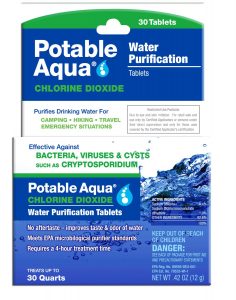 So let’s get started. Iodine or chlorine dioxide? Drops or tablets? Of the two chemicals, chlorine dioxide treats a broader spectrum of pathogens, including cryptosporidium, which iodine does not. Both have treatment times of about 35 minutes for clear water at room temperature. The exception of course is water with high turbidity and cloudiness which can require treatment times of up to 4 hours. Iodine also leaves a strong taste that does not dissipate over time. Chlorine dioxide treated water has a more palatable taste and eventually evaporates, so the chlorine taste and odor will eventually dissipate while the water is exposed to air (container is left open). Pregnant women should also not be taking iodine, and continuous ingestion can lead to thyroid problems. Regular ingestion of chlorine dioxide is fine. Considering the drawbacks of iodine, we recommend chlorine dioxide if you are going the chemical treatment route. The main downside is that chlorine dioxide is generally slightly more expensive.
So let’s get started. Iodine or chlorine dioxide? Drops or tablets? Of the two chemicals, chlorine dioxide treats a broader spectrum of pathogens, including cryptosporidium, which iodine does not. Both have treatment times of about 35 minutes for clear water at room temperature. The exception of course is water with high turbidity and cloudiness which can require treatment times of up to 4 hours. Iodine also leaves a strong taste that does not dissipate over time. Chlorine dioxide treated water has a more palatable taste and eventually evaporates, so the chlorine taste and odor will eventually dissipate while the water is exposed to air (container is left open). Pregnant women should also not be taking iodine, and continuous ingestion can lead to thyroid problems. Regular ingestion of chlorine dioxide is fine. Considering the drawbacks of iodine, we recommend chlorine dioxide if you are going the chemical treatment route. The main downside is that chlorine dioxide is generally slightly more expensive.
It is important to note that chemical treatments are designed for short term or emergency use and not long term use (more than a few weeks). You can choose between tablets or liquid drops, with tablets being more expensive. With tablets, you’ll need to make sure you keep them dry (especially if you’re in a humid area), while with liquid drops you need to make sure you don’t crack your bottle. Our top pick for chlorine dioxide tablets are either Potable Aqua Chlorine Dioxide tablets (30 pack) or Aquamira chlorine dioxide tablets (50 pack), 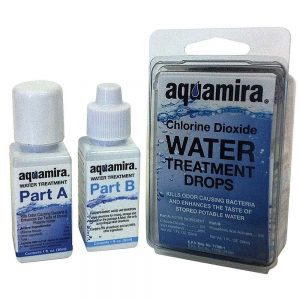 depending on how many you need and which one is offering a better price. If you’d like to go with liquid drops, then we recommend Aquamira’s liquid chlorine dioxide water treatment drops. Simply add 2 drops from each bottle, wait 5 minutes for the chemicals to activate, shake the bottle, then let it sit for 30 minutes. Water will still appear cloudy but the water will be bacteriologically safe.
depending on how many you need and which one is offering a better price. If you’d like to go with liquid drops, then we recommend Aquamira’s liquid chlorine dioxide water treatment drops. Simply add 2 drops from each bottle, wait 5 minutes for the chemicals to activate, shake the bottle, then let it sit for 30 minutes. Water will still appear cloudy but the water will be bacteriologically safe.
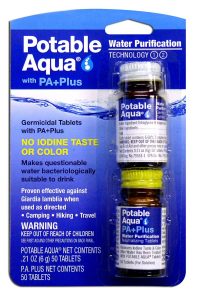 For a healthy adult on a budget, iodine is still a great option. If you just want some purification tablets for emergency use and want the most budget friendly option, then go with Potable Aqua tablets (50 pack) or Potable Aqua with PA+ tablets (50 pack). These are both iodine based germicidal tablets, but the one that comes with PA+ has additional tablets to remove the iodine taste. If you’d like to mask the flavor of iodine, you could also try Crystal Light flavoured drinking powder packets which will make your water much more enjoyable to drink.
For a healthy adult on a budget, iodine is still a great option. If you just want some purification tablets for emergency use and want the most budget friendly option, then go with Potable Aqua tablets (50 pack) or Potable Aqua with PA+ tablets (50 pack). These are both iodine based germicidal tablets, but the one that comes with PA+ has additional tablets to remove the iodine taste. If you’d like to mask the flavor of iodine, you could also try Crystal Light flavoured drinking powder packets which will make your water much more enjoyable to drink.
Best ultraviolet light water purifier
Perhaps you’re sensitive to chemicals or hate the taste of treated water, then germicidal ultraviolet water purification might be what you need. Ultraviolet light has three wavelength categories: UV-A, UV-B and UV-C. The shortest wavelength, UV-C, is able to damage the DNA of pathogens to prevent them from reproducing or functioning properly. This is extremely effective when treating clear water and is a proven method for eliminating all types of pathogens and microorganisms, including viruses. The great thing about this technology is that it avoids any taste issues, health concerns, pumping, or long wait times when disinfecting water. In terms of devices, there is one standout portable UV light purifier, the SteriPen Adventurer, that has been shown to be reliable in the wild. It is powered by two CR123 batteries and can purify a liter of water in only 90 seconds by utilizing UV-C light. It weighs only 3.8 ounces and the light simply needs to be placed inside a water container to work. The SteriPen is reusable up to 8,000 times and you can get a free replacement once the bulb stops working (they claim this is about seven years of daily use). It also has a built-in flashlight that actually works very well at night. This is a extremely good backup or alternative to the typical water treatment drops and tablets most are accustomed to using as long as you have the batteries. This is the biggest drawback is the cost of batteries that can add up over time or that might be hard to find depending on where you are. The second big drawback is that it only works in clear water, or if you have cloudy water, you’ll need to filter it properly first.
Now the same brand does have a little brother, the SteriPen Freedom, which has a rechargeable internal battery instead of using disposable ones. Unfortunately due to many reports of the internal battery not holding a charge over periods of time, we don’t recommend it but instead its bigger brother the SteriPen Adventurer.
As a side note, a little talked about issue is photo reactivation. Once water has been treated with ultraviolet light, it should not be exposed to visible light for a significant period of time. Photoreactivation can potentially repair the DNA of pathogens that have been damaged, which will cause them to become infectious again. It is fine for the water to be exposed to visible light for short periods, but if you have disinfected water in a clear bottle you should make sure it is concealed in a bag during the day.
Best personal portable water filter
In recent years water filters have taken some big technological leaps. There’s currently a few incredibly amazing portable water filters that are being used around the world where treating and filtering water is a life or death situation. A good filter will strain out bacteria and protozoa, but they won’t stop viruses that are too tiny for filters. Admittedly in most areas viruses are not a concern, especially for short or occasional trips, so a good filter is both feasible and economical. You don’t have to worry about using chemicals or running out of batteries, just drink directly from a water source using the filter without any waiting around.
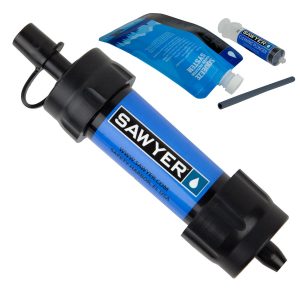 We recommend the award winning Sawyer Mini as the best portable water filter for personal use. It is a versatile straw-style filter that can be used to drink directly from a water source or can attach directly onto a bottle. It weighs in at only 1.4 ounces and can filter 100,000 gallons of water over its lifetime. The hollow fiber membrane filter comes in at 0.1 microns and is fine enough to remove 99.99999% of all bacteria and protozoa, and with no moving parts to break and no batteries to run out of, it is extremely reliable and cost effective. It comes with a 16 oz collapsible drinking pouch — simply fill up the pouch from a reasonable water supply and screw the filter directly on and you’re good to go. There is also a straw extension if you want to drink directly from a water source without using the pouch. The Sawyer Mini will also attach onto standard threaded water bottles or can be used inline on a hydration pack. Overall, it is a near perfect personal water filter and is an upgrade over its larger brother the Sawyer Squeeze.
We recommend the award winning Sawyer Mini as the best portable water filter for personal use. It is a versatile straw-style filter that can be used to drink directly from a water source or can attach directly onto a bottle. It weighs in at only 1.4 ounces and can filter 100,000 gallons of water over its lifetime. The hollow fiber membrane filter comes in at 0.1 microns and is fine enough to remove 99.99999% of all bacteria and protozoa, and with no moving parts to break and no batteries to run out of, it is extremely reliable and cost effective. It comes with a 16 oz collapsible drinking pouch — simply fill up the pouch from a reasonable water supply and screw the filter directly on and you’re good to go. There is also a straw extension if you want to drink directly from a water source without using the pouch. The Sawyer Mini will also attach onto standard threaded water bottles or can be used inline on a hydration pack. Overall, it is a near perfect personal water filter and is an upgrade over its larger brother the Sawyer Squeeze.
 There is another option we highly recommend, the excellent LifeStraw. This ingenious and award-winning device once led the way in setting the standard for portable personal water filters. It is extremely effective and cheap and has been used throughout the world where access to clean water is limited. Like the Sawyer Mini, the LifeStraw is not designed for purifying large containers of water, but is used like a straw to drink directly from a water source. The main reason that the LifeStraw isn’t our favorite personal water filter is because it really is only a straw filter and only has a lifespan of 264 gallons, compared to the Mini‘s 100,000 gallons. It also cannot attach onto any standard bottle mouth and doesn’t come with a collapsible container. You can purchase the LifeStraw Go bottle which has the the filter within it, but the bottle nor the LifeStraw itself is as portable compared to the Sawyer Mini.
There is another option we highly recommend, the excellent LifeStraw. This ingenious and award-winning device once led the way in setting the standard for portable personal water filters. It is extremely effective and cheap and has been used throughout the world where access to clean water is limited. Like the Sawyer Mini, the LifeStraw is not designed for purifying large containers of water, but is used like a straw to drink directly from a water source. The main reason that the LifeStraw isn’t our favorite personal water filter is because it really is only a straw filter and only has a lifespan of 264 gallons, compared to the Mini‘s 100,000 gallons. It also cannot attach onto any standard bottle mouth and doesn’t come with a collapsible container. You can purchase the LifeStraw Go bottle which has the the filter within it, but the bottle nor the LifeStraw itself is as portable compared to the Sawyer Mini.
Best gravity filtration system (groups)
When treating large quantities of water for a group of people for drinking, cooking or cleaning, you’ll need an easy solution for filtering water efficiently. Sometimes finding sources of water to use can be difficult, and it is important to be prepared for everyone’s sake. Using a personal water filter would be extremely tedious and time consuming when there are better gravity and pump filters designed for filtering bulk water. These types of filter can be a simple and inexpensive water insurance policy.
 The two best gravity filters are the Platypus GravityWorks and the MSR AutoFlow Gravity Filter. For most camping and emergency situations, the GravityWorks offers the easiest solution. Simply fill up one bag with dirty water and let the clean water filter using gravity into the secondary bag. There’s no need to use a pump, its easy to use, lightweight (12 ounces empty) and can filter about 4 liters in 3 minutes. Its always great to let it hang and filter while you’re setting up camp so you have clean water ready to use by the time you’re done. Gravity filters work best when you have an easily accessible source of water where you can scoop it up, and isn’t designed for situations where water will be difficult to retrieve. In those cases, you’ll want a pump filter instead to suck up water from things like puddles.
The two best gravity filters are the Platypus GravityWorks and the MSR AutoFlow Gravity Filter. For most camping and emergency situations, the GravityWorks offers the easiest solution. Simply fill up one bag with dirty water and let the clean water filter using gravity into the secondary bag. There’s no need to use a pump, its easy to use, lightweight (12 ounces empty) and can filter about 4 liters in 3 minutes. Its always great to let it hang and filter while you’re setting up camp so you have clean water ready to use by the time you’re done. Gravity filters work best when you have an easily accessible source of water where you can scoop it up, and isn’t designed for situations where water will be difficult to retrieve. In those cases, you’ll want a pump filter instead to suck up water from things like puddles.
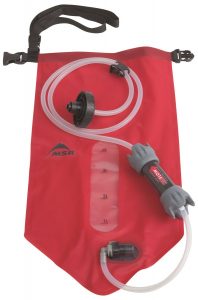 The MSR AutoFlow is very similar to the GravityWorks and functions using the same gravity filter method. The biggest difference is that the MSR is designed to filter directly into your own water container or bottle, and does not come with a secondary bag. The overall weight is also about 2 ounces heavier. Nevertheless, is still works extremely efficiently and is simple to use. Just scoop water directly into the 4 liter bag, roll the top and let it hang. Place the hose into your water container such as a bottle or pot and watch the water start flowing out. Again, because it does not come with a secondary bag built-in, this does require paying a little bit more attention unless you have it set up to drain into a water bladder. Another important difference between the MSR AutoFlow and the Platypus GravityWorks is that the MSR is easier to close with a roll-top design, whereas the GravityWorks requires using a zipper that can sometimes be difficult to use, especially in colder weather. Other than these differences, they both have the same capacity, maintenance procedures, and filter lifespan (1500 liters). Both are fantastic and are great for filtering large amounts of water for groups, it simply depends on your preferences in the small differences.
The MSR AutoFlow is very similar to the GravityWorks and functions using the same gravity filter method. The biggest difference is that the MSR is designed to filter directly into your own water container or bottle, and does not come with a secondary bag. The overall weight is also about 2 ounces heavier. Nevertheless, is still works extremely efficiently and is simple to use. Just scoop water directly into the 4 liter bag, roll the top and let it hang. Place the hose into your water container such as a bottle or pot and watch the water start flowing out. Again, because it does not come with a secondary bag built-in, this does require paying a little bit more attention unless you have it set up to drain into a water bladder. Another important difference between the MSR AutoFlow and the Platypus GravityWorks is that the MSR is easier to close with a roll-top design, whereas the GravityWorks requires using a zipper that can sometimes be difficult to use, especially in colder weather. Other than these differences, they both have the same capacity, maintenance procedures, and filter lifespan (1500 liters). Both are fantastic and are great for filtering large amounts of water for groups, it simply depends on your preferences in the small differences.
Best pump filtration system (groups)
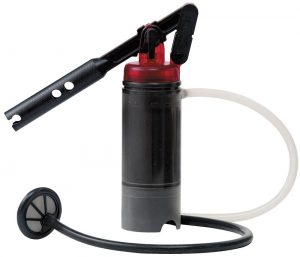 Our favorite pump microfilter is the MSR SweetWater system. It has the most comfortable grip and handle and a very smooth pumping motion. It also has a smaller filter pore size at 0.2 microns than comparable filter pumps, and has shown to be reliable and comfortable to use. The filter lasts for about 750 liters, and can pump about a liter in a minute and a half. The biggest difference between this and a gravity filter is that this allows you to pump water from smaller and dirtier water sources (small puddles and drips) making it more versatile in desperate situations. It is effective against protozoa, bacteria, Cryptosporidium, particulate and various chemicals and toxins. Overall, we found the MSR SweetWater to be the best overall pump microfilter due to its versatility and ease of use, especially for group situations.
Our favorite pump microfilter is the MSR SweetWater system. It has the most comfortable grip and handle and a very smooth pumping motion. It also has a smaller filter pore size at 0.2 microns than comparable filter pumps, and has shown to be reliable and comfortable to use. The filter lasts for about 750 liters, and can pump about a liter in a minute and a half. The biggest difference between this and a gravity filter is that this allows you to pump water from smaller and dirtier water sources (small puddles and drips) making it more versatile in desperate situations. It is effective against protozoa, bacteria, Cryptosporidium, particulate and various chemicals and toxins. Overall, we found the MSR SweetWater to be the best overall pump microfilter due to its versatility and ease of use, especially for group situations.
If you don’t want to use chemicals but are still very concerned about viruses, we suggest the First Need XLE portable water purifier. This is the only filter that is effective against viruses, but it is unfortunately rather heavy and clunky and we wouldn’t recommend it for hiking or camping. The filter is 0.1 microns and lasts for about 567 liters. Our strongest recommended treatment for viruses is going to be a chemical treatment such as chlorine dioxide, then a UV purifier, then this.

